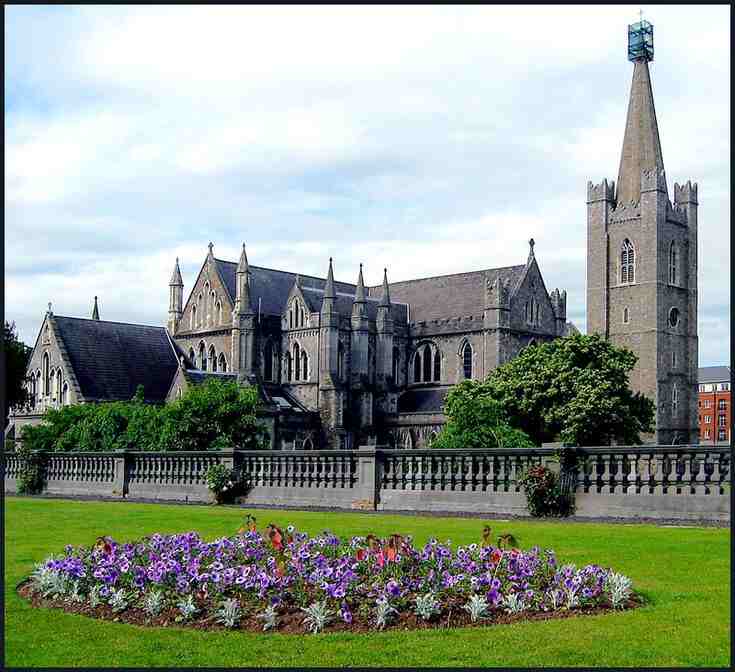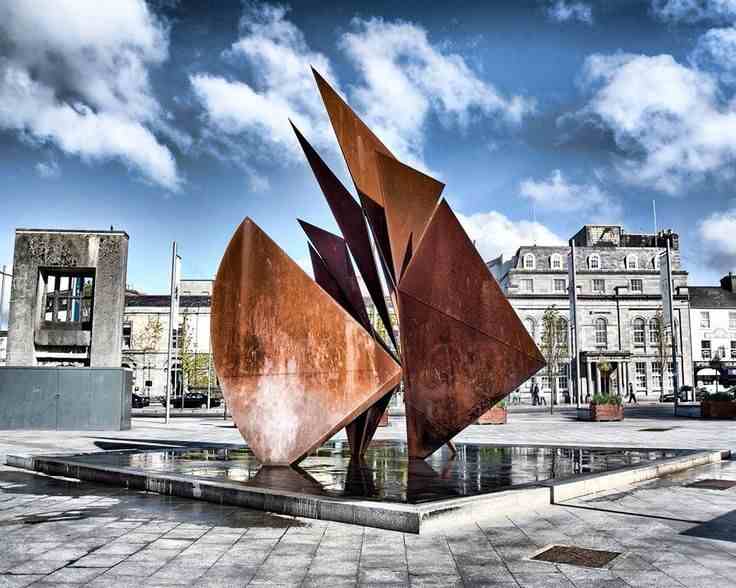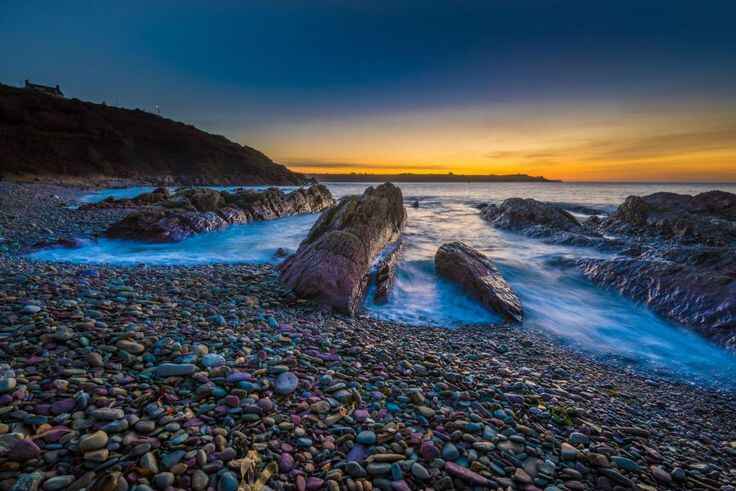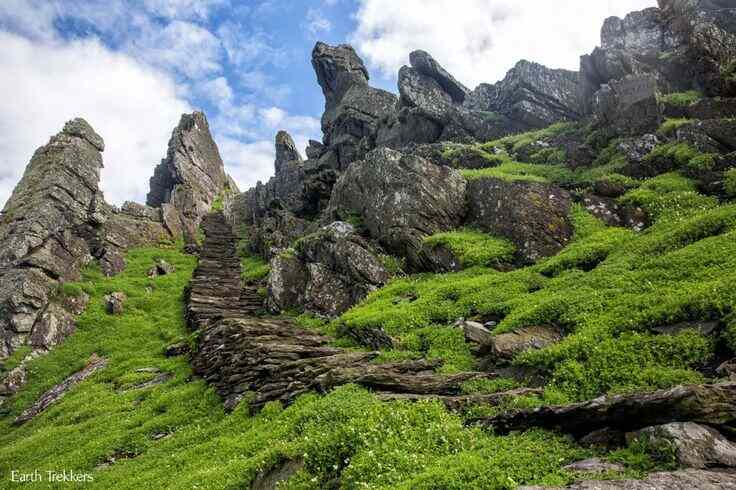Best Places To Travel In Ireland
1.Dublin
Dublin Castle

Dublin Castle: Dublin Castle, located in the heart of Dublin, is a historic castle complex with a rich history dating back to the 13th century. Originally built as a defensive fortress, it has served various roles over the centuries, including as the seat of British rule in Ireland and a venue for important state functions. Today, it hosts government ceremonies, cultural events, and offers guided tours that showcase its medieval and Georgian architecture, including the State Apartments, the Chapel Royal, and the medieval undercroft.
Ireland: Ireland, known as the Emerald Isle, is a lush, green island located in the North Atlantic. It is renowned for its scenic beauty, with rolling hills, dramatic coastlines, and vibrant cities. The Republic of Ireland occupies most of the island and is a sovereign nation with a rich cultural heritage, including traditional music, folklore, and literature. The island is also known for its historic sites, from ancient ruins and castles to vibrant modern cities like Dublin and Galway.
Best Months to Visit
The best time to visit Dublin Castle is typically during the spring and early autumn months, from April to June and September to October.
April to June offers blooming gardens and comfortable temperatures, while September and October provide a quieter experience with cooler weather.
Open Days And Timing
Dublin Castle is generally open to visitors daily, but the specific hours can vary. As of the latest information:
- Opening Hours: Dublin Castle is typically open from 9:45 AM to 5:15 PM, with extended hours during the summer months.
- Closed: It is usually closed on December 24th, 25th, and 26th.
Ticket
As of the latest information, ticket prices for Dublin Castle are approximately:
- Adults: €12
- Seniors (over 65) and Students: €10
- Children (under 12): Free
Guided Tours: There is an additional fee for guided tours, which are usually around €5 per person on top of the admission fee.
Near By Location
Dublin Castle is centrally located, making it convenient to explore several nearby attractions. Here are some nearby places you might want to visit:
Trinity College Dublin: Home to the famous Book of Kells and the beautiful Long Room in the Old Library. It’s about a 10-minute walk from Dublin Castle.
St. Patrick’s Cathedral: A short walk from the castle, this historic cathedral is the largest in Ireland and offers beautiful architecture and rich history.
Christ Church Cathedral: Another impressive cathedral nearby, known for its medieval architecture and historic crypt. It’s about a 10-minute walk from Dublin Castle.
Temple Bar: A vibrant cultural quarter with pubs, restaurants, and galleries. It’s a 5-10 minute walk from Dublin Castle.
The National Museum of Ireland – Archaeology: Located on Kildare Street, this museum is about a 15-minute walk from the castle and offers fascinating exhibits on Irish history and archaeology.
Grafton Street: Dublin’s main shopping street, where you can enjoy shopping, street performers, and cafes. It’s around a 10-15 minute walk from Dublin Castle.
The Little Museum of Dublin: A charming museum located on St. Stephen’s Green, about a 15-minute walk from the castle.
Phoenix Park: One of Europe’s largest city parks, offering vast green spaces and attractions like Dublin Zoo. It’s a bit further but can be reached by a short bus or taxi ride.
2.Galway
Eyre Square

Eyre Square: Located in the heart of Galway, Eyre Square is the city’s central public space and a lively gathering spot. It’s surrounded by shops, cafes, and historic landmarks. The square features several sculptures and statues, including the statue of John F. Kennedy. It’s a hub of activity and a great place to experience the local atmosphere.
Galway: Galway is a vibrant city on Ireland’s west coast known for its artistic flair, rich cultural heritage, and welcoming atmosphere. It’s famous for its lively festivals, traditional Irish music, and historic streets. Surrounded by stunning natural landscapes, including Connemara and the Aran Islands, Galway offers a unique blend of urban energy and scenic beauty.
Best Months to Visit
The best time to visit Eyre Square is during the late spring to early autumn, specifically from May to September.
May and June offer warmer weather and fewer crowds compared to the peak summer months, while July and August are vibrant with various cultural activities, though they can be busier with tourists. September is a good time as well, with the weather still relatively warm and the crowds starting to thin out.
Open Days And Timing
Eyre Square is an open public space, so there are no specific opening hours or days.
Ticket
Eyre Square is a public space and does not require an admission ticket. It’s freely accessible to everyone at all times, so you can visit and enjoy the square without any cost.
Near By Location
Spanish Arch: A historic landmark and part of the old city walls, located a short walk from Eyre Square. It offers views of the River Corrib and is near the Galway City Museum.
Galway Cathedral: About a 10-minute walk from Eyre Square, this stunning cathedral features impressive architecture and beautiful stained glass windows.
Quay Street: A vibrant street in the Latin Quarter filled with colorful shops, pubs, restaurants, and entertainment. It’s a lively area to explore, just a short walk from the square.
Galway City Museum: Located near the Spanish Arch, this museum offers exhibits on Galway’s history, culture, and archaeology.
Salthill Promenade: A scenic coastal walk along Galway Bay, offering stunning views and a chance to enjoy the sea breeze. It’s about a 20-minute walk or a short bus ride from Eyre Square.
The Claddagh: A historic area known for its traditional fishing village charm, located close to the Spanish Arch.
Eyre Square Shopping Centre: Adjacent to the square, this shopping center offers a range of retail options and dining choices.
3.Cork
Cork Harbour

Cork Harbour: Cork Harbour is one of the largest natural harbors in the world, located on the south coast of Ireland. It’s a bustling maritime hub with a picturesque setting, featuring a mix of historic docks, scenic waterfronts, and charming coastal towns. The harbor is an excellent spot for boat tours, offering views of the city, maritime activities, and the nearby islands.
Cork: Cork is a vibrant city in southwestern Ireland known for its rich history, cultural diversity, and lively atmosphere. The city sits on the River Lee and boasts a range of attractions, including historic sites like Cork City Gaol, the bustling English Market, and beautiful parks such as Fitzgerald Park. Cork is also a gateway to scenic areas like Kinsale and Blarney, making it a great base for exploring the region.
Best Months to Visit
The best time to visit Cork Harbour is during the late spring to early autumn, specifically from May to September. During these months, the weather is generally mild and pleasant, making it ideal for enjoying outdoor activities and boat tours around the harbor.
May and June: Offer mild temperatures and fewer crowds, providing a more relaxed experience while exploring the harbor and surrounding areas.
July and August: Are the warmest months with the most sunshine, perfect for outdoor activities and experiencing local events and festivals. However, these months can be busier with tourists.
September: Offers a good balance of pleasant weather and reduced tourist crowds, making it a great time for a more peaceful visit.
Open Days And Timing
Cork Harbour is a natural harbor, so it is always accessible and open for visitors. However, specific attractions and activities within the harbor area might have varying opening hours. Here are some key points to consider:
Boat Tours: Many boat tours and excursions operate seasonally, typically from late spring to early autumn. The timing and availability of these tours can vary, so it’s best to check with individual operators for current schedules.
Maritime Attractions: Attractions like the Cobh Heritage Centre and other maritime-related sites may have specific opening hours. For example:
- Cobh Heritage Centre: Generally open daily from around 10 AM to 5 PM, but it’s advisable to check their website for the latest information.
Public Areas: The public spaces around Cork Harbour, including promenades and walking paths, are accessible at all times.
Ticket
Cork Harbour itself, being a natural area, does not require a ticket for general access. You can freely explore the waterfront, promenades, and public spaces around the harbor.
However, if you plan to visit specific attractions or take part in activities, such as boat tours or visits to maritime museums, there may be associated costs. Here are a few examples:
Boat Tours: Prices for boat tours around Cork Harbour can vary depending on the operator and the type of tour. Typically, tickets range from €15 to €30 per person.
Maritime Attractions:
- Cobh Heritage Centre: Entry fees are usually around €10 to €15 per adult. Children and group rates may vary.
Near By Location
Cobh: A charming town located at the entrance of Cork Harbour. Known for its colorful houses, the Titanic Experience museum, and St. Colman’s Cathedral. It’s a short drive or train ride from Cork City.
Cork City: Just a short distance from the harbor, Cork City offers attractions like the English Market, Cork City Gaol, and Fitzgerald Park.
Fota Island: Home to Fota Wildlife Park, which is a popular attraction for families, and Fota House and Gardens, which offer beautiful landscapes and historical insights. It’s accessible by a short drive or train ride.
Crosshaven: A quaint village near Cork Harbour, known for its marina and scenic views. It’s a great spot for a relaxing visit and enjoying the coastal ambiance.
Kinsale: A picturesque seaside town located about 30 minutes from Cork Harbour, known for its excellent seafood, historic sites like Charles Fort, and vibrant arts scene.
Blarney: Famous for Blarney Castle and the Blarney Stone. It’s a short drive from Cork Harbour and offers beautiful gardens and historic sites.
Midleton: Known for the Jameson Distillery Visitor Centre, where you can learn about the history of Jameson whiskey and enjoy tastings.
Blackrock Castle: Located on the outskirts of Cork City, this historic castle has been converted into an observatory and visitor center with exhibitions on space and astronomy.
4.Kerry
Skellig Michael

Skellig Michael: Skellig Michael is a dramatic, isolated island off the coast of County Kerry, Ireland. It is renowned for its steep, rugged cliffs and its ancient monastic settlement, which dates back to the 6th century. The island is a UNESCO World Heritage Site and features well-preserved beehive huts and early Christian artifacts. It’s also famous for its rich birdlife and as a filming location for “Star Wars: The Force Awakens.”
County Kerry: County Kerry, located in southwestern Ireland, is celebrated for its stunning landscapes, including mountains, lakes, and coastline. Key attractions include the scenic Ring of Kerry, Killarney National Park, and the picturesque Dingle Peninsula. The county is known for its vibrant towns, such as Killarney and Dingle, and its beautiful natural sites like Skellig Michael and Valentia Island. Kerry offers a mix of outdoor adventures, historical sites, and charming Irish culture.
Best Months to Visit
The best time to visit Skellig Michael is during the summer months, specifically from May to September. During this period, the weather is generally more favorable for boat trips, and the island’s access is more reliable.
May and June: Offer mild weather and fewer crowds, making for a pleasant visit and easier booking of boat trips.
July and August: Are the warmest months with the longest daylight hours, ideal for exploring the island. However, this is also the peak tourist season, so it can be busier.
September: Provides a good balance of decent weather and fewer tourists compared to the peak summer months.
Open Days And Timing
Skellig Michael is accessible to visitors primarily from early May to late September. The specific timing for visiting the island is dependent on weather conditions and the availability of boat trips.
Boat Trips:
- Season: Boat trips to Skellig Michael generally run from early May to late September. The exact dates can vary each year based on weather and sea conditions.
- Timing: Boats typically depart in the morning and return in the afternoon. Exact departure times can vary depending on the tour operator and weather conditions. It’s best to check with the tour operators for specific schedules.
Island Visits:
- Access: The island is usually open for visitors from around 10 AM to 4 PM, though this can vary based on weather conditions and sea conditions.
- Guided Tours: Most visits are via guided tours, which must be booked in advance. Tours are weather-dependent, and the island may be closed if conditions are too rough.
Booking and Availability:
- Advance Booking: Due to high demand, it is essential to book your boat trip well in advance, especially during peak season.
- Weather Conditions: The island is subject to weather conditions, and trips may be canceled if the sea is too rough or conditions are unsafe.
Ticket
To visit Skellig Michael, you need to book a boat trip, which includes the cost of transportation to and from the island. Here’s a general idea of ticket pricing:
Boat Trip Costs:
- Price Range: Boat trips to Skellig Michael generally cost between €70 and €100 per person. The price can vary based on the tour operator, the season, and the type of tour (e.g., standard or private).
- Booking: Tickets for boat trips must be booked in advance, especially during the peak summer months. It’s advisable to book as early as possible due to high demand.
Included in the Ticket:
- Transportation: The ticket price covers the boat journey to and from Skellig Michael.
- Landing Fees: Some operators include landing fees for the island in the ticket price.
Additional Costs:
- Guided Tours: Some boat operators offer guided tours for an additional fee.
- Climbing the Steps: There’s no extra charge to climb the steps on the island, but be prepared for a strenuous climb.
Booking and Cancellation:
- Booking: You can book tickets through various tour operators based in Portmagee, Ballinskelligs, or other nearby towns.
- Cancellation: Be aware of the cancellation policy of the tour operator, as weather conditions can affect the schedule.
Near By Location
Portmagee: A charming village located on the mainland, serving as a primary departure point for boat trips to Skellig Michael. It offers picturesque views, local pubs, and small shops. The village is also known for its seafood and traditional Irish charm.
Valentia Island: Accessible via a bridge from Portmagee, Valentia Island features beautiful coastal scenery, the Valentia Lighthouse, and the Tetrapod Trackways, which are ancient fossilized footprints. The island is known for its stunning landscapes and historical sites.
Ballinskelligs: A nearby village with scenic views of the Atlantic Ocean. It’s a good spot for exploring beaches, such as Ballinskelligs Beach, and visiting the nearby Skellig Experience Visitor Centre, which provides information about Skellig Michael and its history.
Cahersiveen: A historic town located about a 30-minute drive from Portmagee. It offers attractions such as the Cahergall and Leacanabuaile stone forts and the scenic Ring of Kerry.
Killarney: A larger town located approximately 1.5 to 2 hours drive from Portmagee, known for its beautiful lakes, Killarney National Park, and historic sites like Muckross House.
The Ring of Kerry: A scenic driving route that starts near Killarney and passes through beautiful landscapes, including mountains, lakes, and coastal views. It’s a great way to explore the broader Kerry region.
Dingle Peninsula: A bit farther away, this peninsula offers dramatic coastal scenery, charming towns like Dingle, and historic sites such as Gallarus Oratory.
